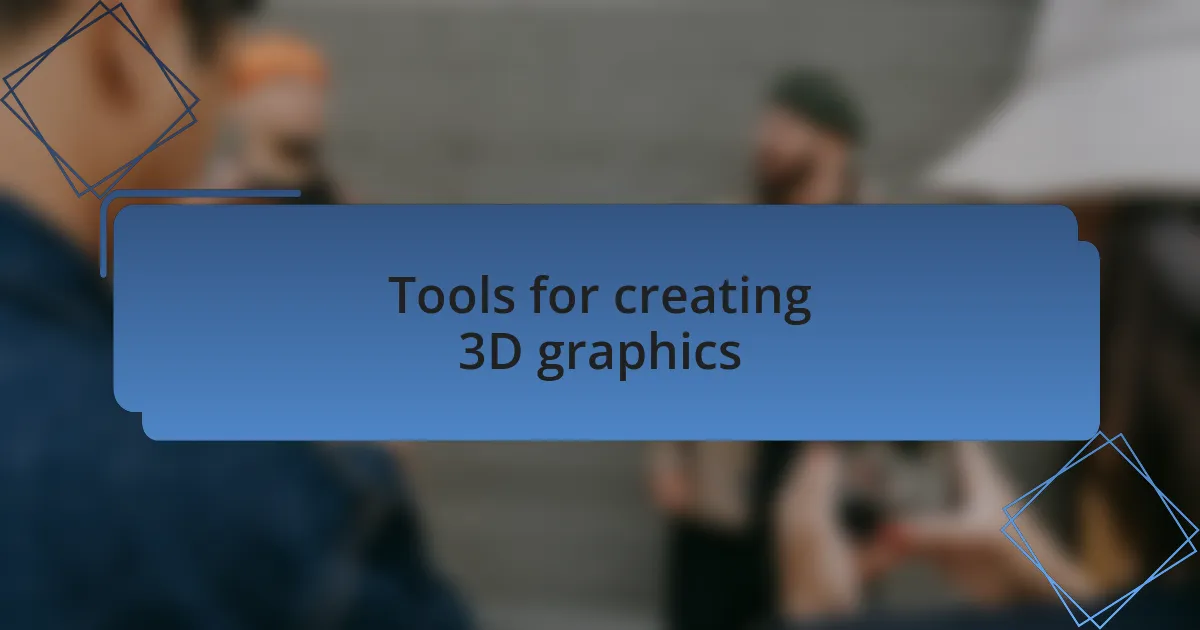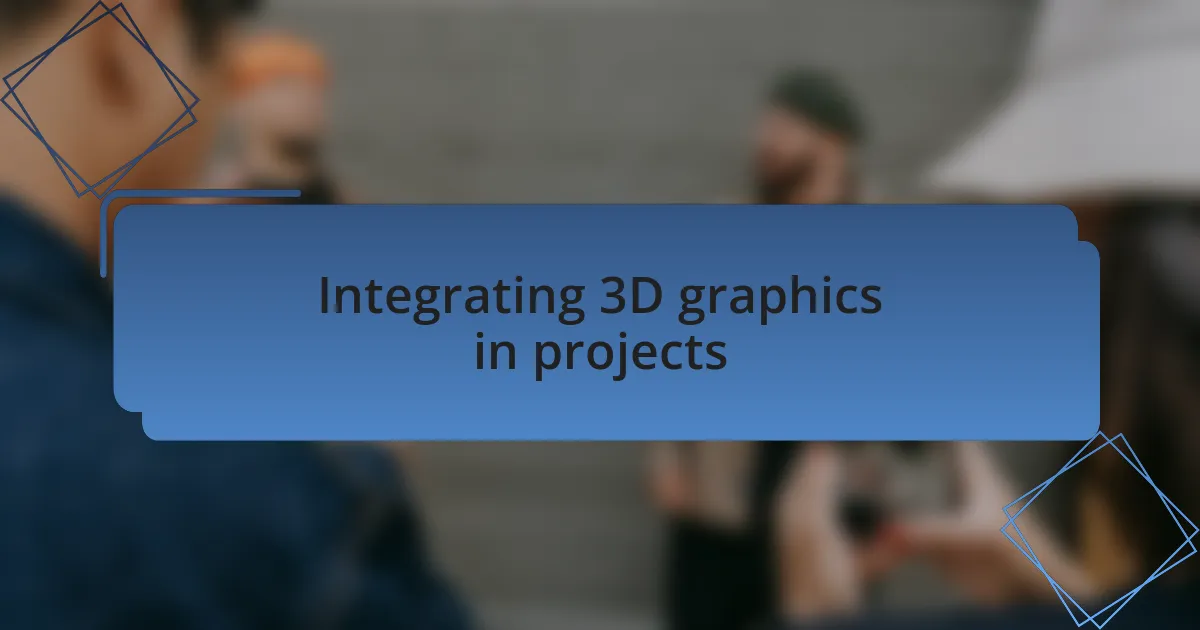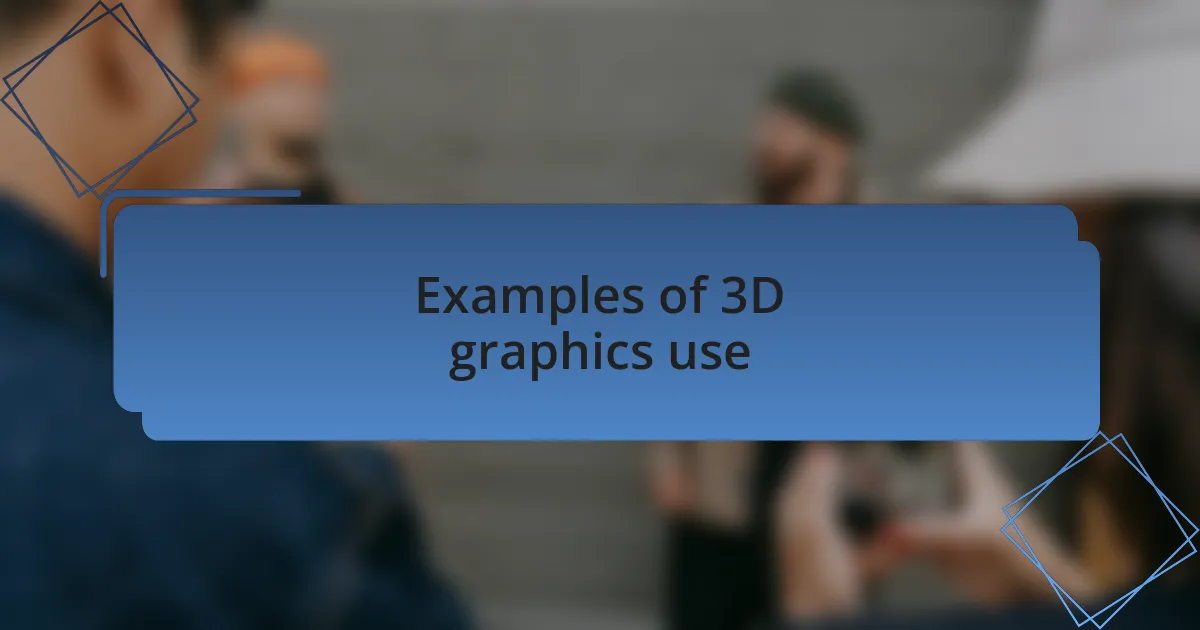Key takeaways:
- Blender and Autodesk Maya are highlighted as top tools for creating 3D graphics, with Blender being budget-friendly and highly effective.
- Cinema 4D is praised for its user-friendly interface, particularly for motion graphics and intricate texture animations.
- Integrating 3D graphics enhances projects by transforming static concepts into engaging, interactive experiences that improve consumer engagement.
- 3D graphics can captivate audiences by making complex concepts relatable, as demonstrated through immersive marketing campaigns and presentations.

Tools for creating 3D graphics
When it comes to creating 3D graphics, I’ve found that tools like Blender and Autodesk Maya truly stand out. Blender, in particular, is an open-source powerhouse that’s perfect for anyone on a budget but still serious about 3D work. I remember the first time I rendered a project—I was astounded by the level of detail I could achieve with just a few hours of practice.
Another tool that has captured my interest is Cinema 4D. Its intuitive interface makes it easy to dive into motion graphics, which is essential in today’s fast-paced digital landscape. I vividly recall working on a project where I needed to animate intricate textures. The way Cinema 4D seamlessly handled lighting and shadowing made me feel like a professional, and I couldn’t believe how much time I saved compared to other software.
For those venturing into augmented reality, Unity is a game-changer. It lets you integrate 3D elements into real-world environments. I can still recall the thrill of watching my designs come to life in a virtual space—it was like a dream where my creativity blended with technology in real-time. Have you ever experienced that rush when a tool simply clicks with your vision? That’s the magic that these 3D graphics tools can offer.

Integrating 3D graphics in projects
Integrating 3D graphics into projects can be immensely satisfying, transforming a static concept into a vibrant, interactive experience. I recently worked on a product showcase for a Samsung smartphone, which involved creating lifelike 3D renderings. Seeing the product emerge from flat images into a dynamic model enhanced my understanding of how visuals can impact consumer engagement.
I remember the challenge of coordinating 3D elements with existing 2D graphics in one project. By meticulously layering textures and employing motion to highlight features, the final result not only looked stunning but also communicated the smartphone’s capabilities effectively. Have you ever paused to consider how a well-integrated visual can communicate complex ideas in a simpler way? That’s the beauty of a well-executed 3D integration.
Moreover, collaborating with team members brought fresh insights into integrating 3D into websites and promotional materials. I was surprised how even minor adjustments, like animating transitions or enhancing backgrounds, elevated the overall aesthetic without overshadowing the main subject. The learning journey reminded me that innovative integration isn’t just about advanced tools; it’s about aligning creativity with purpose for maximum impact.

Examples of 3D graphics use
When I worked on a marketing campaign for a Samsung device, we incorporated 3D graphics to create an interactive user guide. The 3D models allowed users to rotate and explore features in a way that felt almost like holding the phone in their hands. It made me realize how immersive experiences can drive consumer interest—you just can’t achieve that level of engagement with traditional 2D images.
In another project, I developed a stunning 3D animation that demonstrated the smartphone’s camera capabilities. By simulating a photo shoot, we showcased various shooting modes and effects. The response was overwhelming; viewers didn’t just see the features; they experienced them. Isn’t it fascinating how visual storytelling can transform technical specifications into an enticing narrative?
I remember a specific instance during a client presentation where we used 3D graphics to illustrate the phone’s design process. Using a dynamic 3D walkthrough captivated everyone in the room, making them feel part of the development journey. It hit me then how effectively visual aids could make complex concepts relatable. Have you considered how a well-crafted display can evoke emotions and make technical details more accessible? That’s the power of 3D graphics—bringing ideas to life in a way that resonates with the audience.